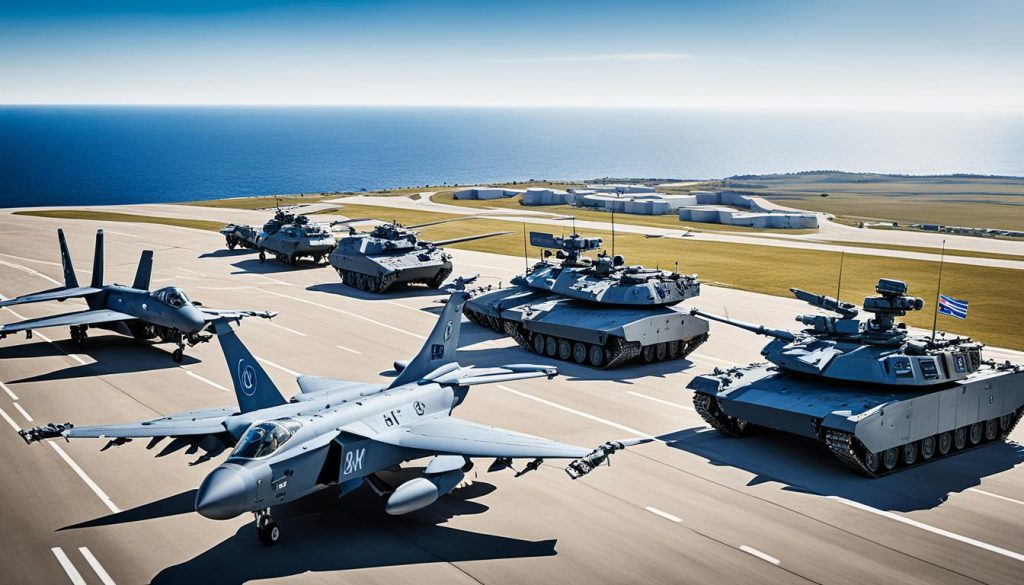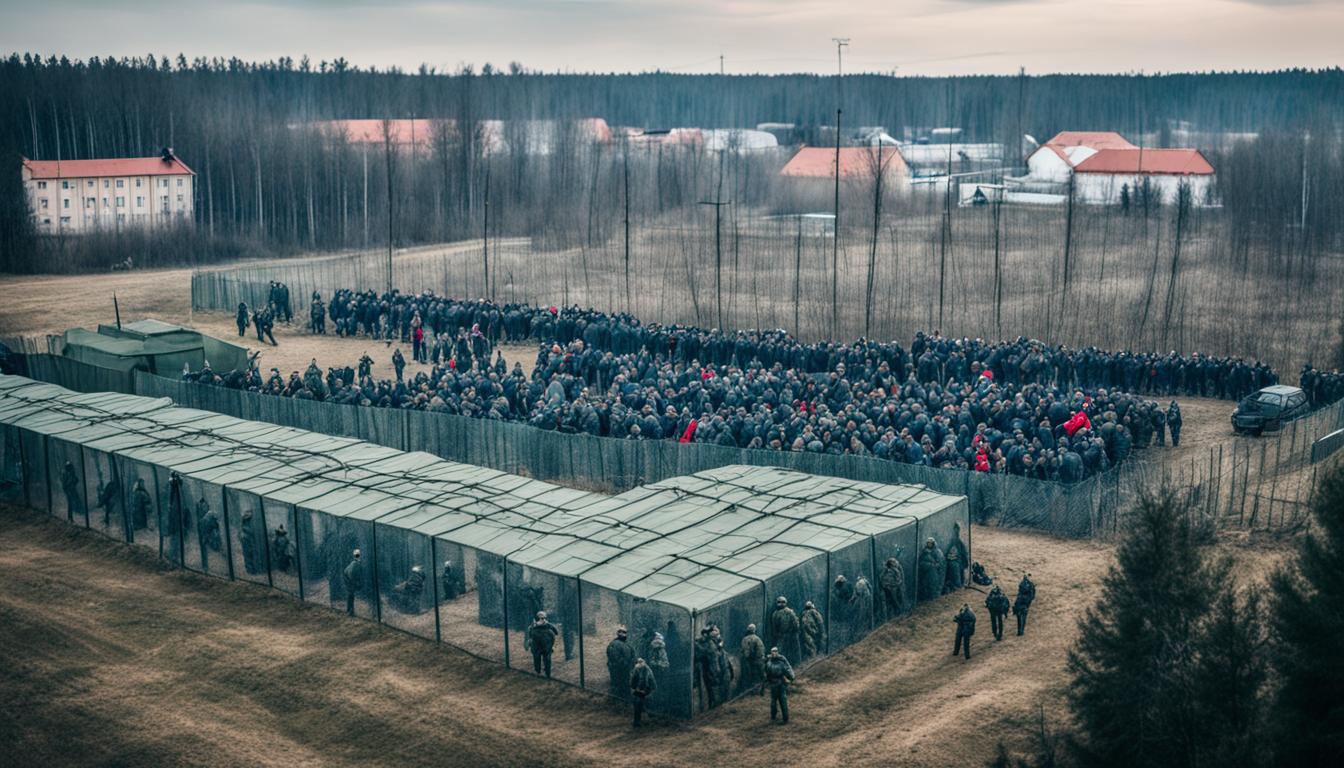The situation at the Belarus-Poland border has caught the world’s eye as politics and care for people merge. What started as tension has grown into a major geopolitical issue. People around the world are watching. The crisis over migration at the Poland border shows the big challenges the EU faces in keeping its borders safe while tensions rise.
As the EU works through this crisis, the focus on helping people has grown. Many groups are highlighting the terrible conditions now. At the same time, countries involved are trying to find a fine line. They need to protect their own lands but also work together globally. We aim to give you new insights into what’s happening and how it’s being handled.
Key Takeaways
- The evolving geopolitical conflict at the Belarus-Poland border has raised alarm internationally.
- Strains on Poland migration crisis reflect broader EU border security challenges.
- Humanitarian concerns are intensifying with the increasing number of affected individuals.
- International diplomacy plays a pivotal role in mediating and resolving the escalating tensions.
- Efforts to reconcile state sovereignty with humanitarian imperatives are now in the global spotlight.
- The crisis is a test of the EU’s ability to effectively manage its external borders in times of strife.
The Ongoing Belarus Poland Border Standoff
The cold border between Belarus and Poland is now a scene of geopolitical strife. It tests the strength of EU external border rules. People seeking political asylum face strict border policy. The world watches closely as the situation develops.

Trigger Factors and Political Tensions
The situation is tense, partly due to the Lukashenko regime’s actions. These actions sparked the conflict and led to sanctions from the EU. This made things worse. NATO keeps an eye on its Eastern flanks, mixing military aims with political fears.
Migratory Pressures and Humanitarian Concerns
Many crises come together here. Those running from chaos face a closed EU external border. This raises global concern. NGOs trying to help meet weary border guards. This creates a mix of stories about human rights and big challenges, all watched by the UNHCR.
| Pressure Point | Humanitarian Response | Policy Outcome |
|---|---|---|
| EU External Border | Increased NGO Activity | Enhanced Security Measures |
| Political Asylum Seekers | UNHCR Advocacy | Review of Asylum Protocols |
| Sanctions Impact | Human Rights Watch Monitoring | International Diplomatic Dialogues |
International Responses to the Escalating Situation
The crisis is getting worse, and the world reacts differently. The EU’s sanctions show they don’t agree with Minsk. News stories highlight how serious it is. People are trying to deal with the political mess while thinking about border security measures.
The number 3 may seem odd in this context. But it stands for the countries involved: the home country, Belarus, and Poland (for the EU). Each has a key role in adding to the tension or finding solutions.
Implications of the Belarus Poland Border Crisis
The Belarus Poland border crisis has shaken the world. It has made us look closely at EU-Russia relations, transatlantic alliances, and the need for changes in migration policy. All these factors are linked. They show how the crisis could upset regional stability and lead to significant economic impact.
-
The crisis highlights tensions between the EU and Russia. The EU’s border policies reflect its wider political stance. They spark discussions on security in the region and how the East and West relate.
-
The reaction of transatlantic alliances to the border tensions shows the West’s united but careful support. They aim to maintain Europe’s unity against the East. This situation tests how well NATO’s defence and foreign policies work together.
-
There’s now a push for changes in migration policies. Europe is facing unpredictable migration patterns. Any policy changes need to balance the safety of people with the need for security.
-
Regional stability is at risk due to border disputes. These disputes upset the political balance in nearby countries. They also affect what people think and the plans of governments.
-
The crisis’s economic effects are very serious. It puts a strain on resources and might lead to trade issues. This could challenge the economy of the regions involved.
As per a think tank’s strategic assessment, “The border crisis necessitates an urgent yet well-deliberated array of responses, encompassing diplomacy, defence, and humanitarian considerations, to mitigate the reverberating consequences.”
Below is a comparative analysis delineating the affected sectors:
| Aspect | Pre-Crisis Situation | Current Impact |
|---|---|---|
| EU-Russia Relations | Strategic caution and mutual wariness | Escalated tensions and renewed calls for dialogue |
| Transatlantic Alliances | Steadfast NATO commitments to European defence | Increased military and diplomatic collaboration |
| Migration Policy | Regulatory frameworks with progressive inclinations | Reform discussions ignited, prioritising security and rights |
| Regional Stability | Relatively stable borders with sporadic issues | Heightened vigilance and anticipatory policy-making |
| Economic Stability | Robust trade relations and open markets | Prospect of sanctions and heightened security costs |
Conclusion
The Belarus Poland border crisis shows how political, humanitarian, and security issues are connected. It’s crucial to find resolution strategies quickly. We need to work together, involving both affected countries and the wider world.
Policy recommendations suggest a varied plan of action. This includes improving Belarus and Poland’s communication and increasing international oversight by groups like the UN. Changing migration policies to respect human rights and regional stability is also key. It’s important that border crisis management doesn’t make things worse for people at the border or threaten national security.
This problem can be overcome if we all agree to cooperate. By taking careful steps and using smart diplomacy, we can calm the current trouble. This way, we’ll also set good examples for dealing with similar issues in the future. In closing, this article offers a detailed view of the crisis and a vision for a future led by diplomacy and respect for human dignity.
FAQ
What is the current state of the Belarus-Poland border crisis?
The Belarus-Poland border is experiencing a major conflict. Tensions continue to rise. Reports show the EU is boosting border security in response to a humanitarian crisis. Both parties are using diplomacy to solve the issues.
What were the trigger factors for the Belarus-Poland border standoff?
Political actions, the Lukashenko regime’s policies, and EU sanctions started the standoff. The crisis worsened due to political strife and growing migratory pressures.
How have international bodies responded to the crisis?
The European Union and NATO have taken action. They’re using diplomacy and sanctions against Belarus. The crisis is seen as a key security issue.
What is the humanitarian impact of the crisis?
Refugees and asylum seekers are facing tough conditions at the border. Aid groups and NGOs, with the UNHCR’s help, are offering support and fighting for their rights.
What are the wider implications of the crisis for EU-Russia relations and regional stability?
The crisis could worsen EU-Russia relations and spark talks on migration policies. It’s affecting the economy, alliances, and regional power balance.
How is the global media portraying the border crisis?
Media outlets around the world are covering the crisis widely. They’re focusing on its geopolitical importance, the suffering of migrants, and legal issues. Views vary, from criticising policies to highlighting migrant struggles.
What are the proposed resolution strategies for the Belarus Poland border crisis?
Solutions being looked at include diplomatic talks, better border security, and policy changes for crisis management. The EU and others want to ease tensions and help those affected.



